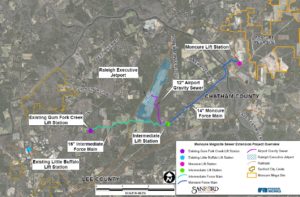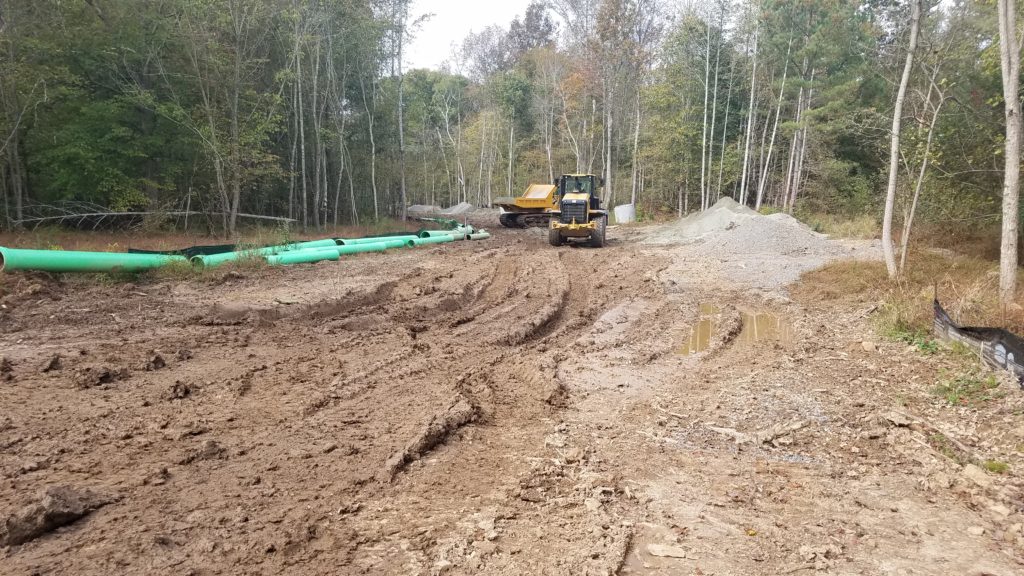Sewer Extension Unlocks Megasite’s Economic Potential
The Moncure Megasite, an undeveloped industrial site in Chatham County, had all the infrastructure needed to become certified through the Economic Development Partnership of North Carolina’s (EDPNC) Certified Site Program – except for one thing: The site lacked wastewater service. To become certified and attract future development, industrial sites must undergo a rigorous prequalification process to meet a consistent set of standards. Through extensive stakeholder coordination and innovative design and bidding processes, Freese and Nichols helped provide the last piece of the puzzle to position the Megasite as the region’s next large-scale industrial facility.
Innovative Application of New/Existing Techniques

As rapid growth in the Triangle Region spreads outward, communities such as Lee and Chatham counties, reliable utility service is essential to attracting new industrial/commercial developments. Businesses evaluating multiple sites favor locations already equipped with water/sewer service. In today’s highly competitive market, Sanford and Chatham County were forward-thinking in their approach to attracting growth by identifying the Moncure Megasite as an ideal location for large-scale industrial development and implementing a plan to extend sewer service to the site and obtain EDPNC Site Certification.
With any project, timing and budget are big factors. However, this project had another important driver: coordination among multiple stakeholders. For instance:
- Sanford and Chatham County developed an interlocal agreement to share both the cost of funding the project and the property tax revenues generated by new development the sewer extension serves.
- Arauco, a company located in Moncure, was contemplating permitting/siting their own treatment plant, and they were willing to participate financially and provide funding and land for the Moncure Lift Station.
- Freese and Nichols facilitated a unique arrangement with Duke Energy to use a portion of Duke’s cross-country transmission easement to reduce the lengths of piping required and minimize land clearing and environmental impacts.
Future Value to Engineering Profession
The flexible design approach and extensive value engineering provided an example for other engineering teams facing similar challenges. The project design involved a careful balance of flexibility and functionality in the face of uncertain future sewer loads. The unknown type/size of future developments made sizing the system a major challenge. The design included a phased construction approach for expansion that allowed the project to stay on budget without sacrificing future capacities. As a result of the strong economy/volatile construction market in the summer of 2018, the original bids for the project came in at $18.8M, significantly higher than original 2016 estimate of $10.5M. Due to the importance of the project and the desire by all stakeholders to get it built, the Freese and Nichols team proceeded with an extensive value engineering effort to lower the project cost without compromising the project intent. Cooperation and negotiation among the owners, contractors and utility companies identified and realized $4.6M of cost reductions.
Social, Economic and Sustainable Design Considerations

The following design considerations maximized benefits to the surrounding communities while minimizing negative impacts:
- Freese and Nichols evaluated multiple pipe alignments, with the selected alignment adjacent to the Duke Energy transmission easement and Hughes Creek. By selecting this route and working with Duke on a unique arrangement to overlap the proposed permanent easement, the amount of land clearing required, wetland/stream impacts and disturbance to property owners were significantly reduced.
- The team designed both the Moncure and Intermediate lift stations to be readily expandable by adding additional larger pumps, and the parcels acquired are big enough for a second, larger lift station to be built on each site. In addition, a larger width of easement was obtained to allow for installation of a second parallel force main.
The decision to invest in extending sewer service to the Moncure Megasite resulted in other benefits to the surrounding community and businesses, including:
- Adding service to the Raleigh Executive Jetport, allowing for expansion of the airport and potential industrial, commercial and residential development adjacent to the airport
- Adding service to the Arauco facility, a major employer in the region, that has a failing on-site wastewater system
- Increasing the likelihood of other future developments that create job opportunities and additional supporting industries across the region
Complexity
Multiple factors contributed to the complexity of this project, including having multiple stakeholders, an accelerated schedule, design considerations, community involvement, funding and bidding/value engineering:
MULTIPLE STAKEHOLDERS
Managing and coordinating with the project stakeholders, both government and private, was essential in completing the project on schedule. In addition to Sanford, Lee County and Chatham County, coordination was vital among Arauco, Duke Energy and the Raleigh Executive Jetport. This project could be completed through the creativity/cooperation of this partnership.
SCHEDULE
The project schedule was heavily driven by the Golden Leaf Foundation (GLF) funds, which required that the project be finished within two years of the grant agreement date. The stakeholders also wanted to get the site certified by the EDPNC as soon as possible, which meant the project would have to be designed, permitted and certified in 12 months.
DESIGN
The challenges presented by the design of the system started with designing for unknown future developments and adding flexibility in the design so that future expansions could be accommodated. Other design challenges included:
- Designing two lift stations to handle the initial average flow of 1 MGD, expandable to 3 MGD, with enough area and a piping configuration to build a second lift station on each site.
- Installing trenchless crossing under the Haw and Deep Rivers and the on-ramp, overpass, off-ramp of US1 and Colon Road with a 2,100 foot and 1,050 foot, respectively, Horizontal Direction Drill.
- Designing over 2,400 feet of trenchless bore/jack crossings, which included crossing 10 NCDOT roads, six railroad crossings, owned by two different companies, and one 500-foot crossing of the Raleigh Executive Jetport runway/taxiway.
- Minimizing impacts to the environment, property owners and Duke Energy along the 12 miles of pipeline.
COMMUNITY INVOLVEMENT

The project required the acquisition of property for two lift stations in addition to 64 private property easements along the pipe alignment. Working directly with the affected property owners to explain the project and help alleviate concerns associated with major land disturbances was an ongoing effort that was critical to the success of the project.
FUNDING
By working closely with Sanford and Chatham County, Freese and Nichols helped secure $5.5M in grants from the GLF and assisted in the development of an interlocal agreement sharing the cost and revenue from the project. Also, Arauco was willing to participate financially and provide land needed for siting a lift station, the terms of which needed to be negotiated.
BIDDING/VALUE ENGINEERING
To allow medium-size local construction firms to bid on the project and to help accelerate the construction schedule, the project was divided into five smaller projects. While this strategy increased the complexity of the bidding and construction process, it was very important to promote a more competitive bidding environment and to avoid attracting only larger regional construction firms. In addition, contractors were allowed to offer a bid price credit for each lift station, if they were awarded both, which reduced the total lift station costs by $1.3M. Due to the economy/volatile construction market, the bids came in higher than the original estimate. Freese and Nichols led the effort to reduce costs without changing the goals of the project. Some of the identified cost savings included:
- Reducing the depths of both lift stations to reduce the volume of rock excavation required
- Modifying the pipe depths and bedding material requirements
- Reevaluating the hydraulic surge analysis to reduce the number of air release valves
- Reducing the gravity sewer size to the Intermediate Lift Station
- Reducing the number of blow-off valve assemblies
- Reconfiguring the force main piping from the Intermediate Lift Station to discharge to the existing Gum Fork Creek Lift Station and redesign it to allow it to handle increased flows
Exceeding Owner Needs
Freese and Nichols worked with Sanford and Chatham County to execute the project to fit their current and future needs and met the accelerated schedule, with construction completed in October 2020. Although the final project cost of $14.2M exceeded the initial budgeted cost of $10.5M, the team lowered the project costs significantly through value engineering, innovative design and stakeholder support. Sanford is starting to realize their vision of becoming a regional provider and has seen their position in the region elevated by taking control of their own destiny and ensuring continued measured growth. The decision to be proactive instead of reactive and accept the financial risk that comes with extending sewer service to the Megasite has put the region in a great position for new development. Since the project was brought online, several developers have inquired about large industrial and residential developments in the area, which are currently in various stages of planning/design/construction.

